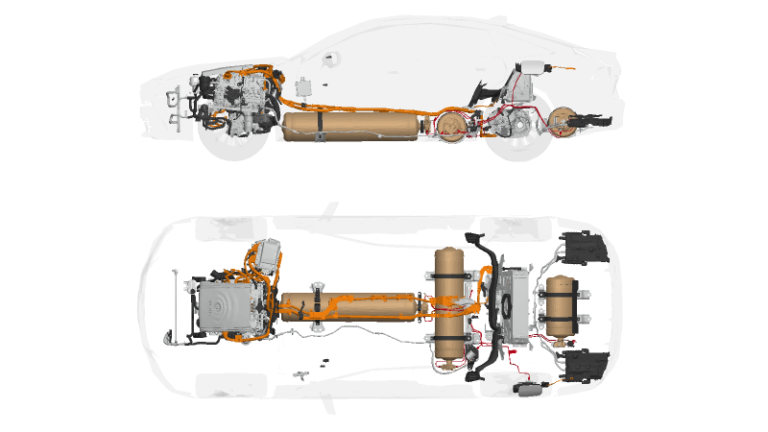5 Must-Read Books for Aspiring Automotive Professionals
The automotive industry is an exciting and dynamic field that offers plenty of opportunities for growth and development. However, if you want to succeed in this field, you need to have the right knowledge and skills.

One of the best ways to gain knowledge and skills is by reading books. Books can provide you with a wealth of information that you can’t get from any other source. In this article, I’m going to share with you 5 must-read books for aspiring automotive professionals. These books cover a range of topics, from the basics of how cars work, the history explaining how the automotive industry got to where its currently, a look into the future of where this industry is going, and the art of leadership in the automotive industry.
“Those who cannot remember the past are condemned to repeat it.” – George Santayana
Engines of Change: A History of the American Dream in Fifteen Cars
“Engines of Change” by Paul Ingrassia is a book that provides a comprehensive history of the American automobile industry. The book covers the rise and fall of the Big Three automakers – General Motors, Ford, and Chrysler – and explores the impact of foreign competitors like Toyota and Honda.
The book is a must-read for anyone interested in the automotive industry because it provides a detailed account of how the industry has evolved over the years. Ingrassia covers the major players, key events, and significant technological advancements that have shaped the industry. By reading this book, aspiring automotive professionals can gain a better understanding of the industry’s history and the factors that have led to its current state.
One key takeaway from the book is the importance of innovation and adaptation. Ingrassia shows how American automakers struggled to adapt to changing consumer preferences and the rise of foreign competitors. The Japanese automakers, on the other hand, were able to innovate and provide consumers with reliable, fuel-efficient cars that met their needs.
Another key takeaway from the book is the importance of effective leadership. Ingrassia shows how the fortunes of the Big Three automakers were largely shaped by their leaders – from Henry Ford to Lee Iacocca. Effective leaders were able to navigate the industry’s challenges and make tough decisions that kept their companies competitive. Overall, “Engines of Change” is a must-read for anyone interested in the automotive industry. It provides valuable insights into the industry’s history and the factors that have shaped its current state.

Car Wars: The Rise, the Fall, and the Resurgence of the Electric Car
“Car Wars” by John Fialka is a book that explores the history of the electric car and the political, economic, and social factors that have shaped its development. The book covers the early beginnings of the electric car in the 1800s to the modern-day advancements in battery technology and the future of electric mobility.
This book is a must-read for anyone interested in the automotive industry because it provides a unique perspective on the electric car revolution and the challenges faced by the industry. Fialka shows how various players – from automakers and oil companies to politicians and activists – have played a role in shaping the industry and the narrative around the electric car.
One key takeaway from the book is the importance of innovation and perseverance. Fialka shows how the electric car faced significant obstacles over the years, including a lack of infrastructure, consumer skepticism, and limited battery technology. However, innovators and entrepreneurs continued to push the boundaries and make progress toward a viable electric car.
Another key takeaway from the book is the importance of collaboration and partnerships. Fialka shows how the success of the electric car depends on a complex network of stakeholders, from automakers and battery manufacturers to utilities and governments. Effective collaboration and partnerships are critical for developing the infrastructure and technologies needed for the widespread adoption of electric vehicles.
Overall, “Car Wars” is a must-read for anyone interested in the electric car revolution and the challenges and opportunities it presents for the automotive industry. It provides valuable insights into the history and future of electric mobility and the key players and factors that will shape the industry’s development.

Are We There Yet?: The American Automobile Past, Present, and Driverless
“Are We There Yet?” by Dan Albert is a book that explores the history of the American car and its cultural impact on society. The book covers the evolution of the car from the early days of the automobile to the modern era of autonomous vehicles.
This book is a must-read for anyone interested in the automotive industry because it provides a fascinating look at the intersection of technology, culture, and society. Albert shows how the car has shaped American society and vice versa, and how cultural attitudes and beliefs have influenced the development of the automobile.
One key takeaway from the book is the importance of understanding the broader societal and cultural context in which the automotive industry operates. Albert shows how cultural values, such as the American obsession with individualism and freedom, have influenced the development of the car and the industry. Understanding these cultural factors is critical for aspiring automotive professionals who need to navigate the complex web of social, economic, and political factors that influence the industry.
Another key takeaway from the book is the importance of innovation and adaptation. Albert shows how the American auto industry has faced numerous challenges over the years, from the rise of foreign competitors to the environmental movement and changing consumer preferences. However, the industry has continued to innovate and adapt to meet these challenges, developing new technologies and products that meet changing consumer needs.
Overall, “Are We There Yet?” is a must-read for anyone interested in the history and cultural impact of the automobile. It provides valuable insights into the complex relationship between technology, culture, and society, and how these factors have influenced the development of the automotive industry.

Fins: Harley Earl, the Rise of General Motors, and the Glory Days of Detroit
“Fins: Harley Earl, the Rise of General Motors, and the Glory Days of Detroit” by William Knoedelseder is a book that tells the story of Harley Earl, the legendary designer who revolutionized the automotive industry with his innovative and artistic designs for General Motors. The book covers the rise of automotive giant General Motors and the pivotal role that Earl played in shaping the company’s image and success.
This book is a must-read for anyone interested in the automotive industry because it provides a fascinating look at the history of automotive artistic design and the impact that it had on the entire industry. Knoedelseder shows how Earl’s visionary designs transformed the automotive industry and set the standard for automotive design for decades to come.
One key takeaway from the book is the importance of creativity and innovation in the automotive industry. Earl’s designs were revolutionary for their time, incorporating new materials, technologies, and styles that captured the imagination of consumers and set General Motors apart from its competitors, thus helping GM become the largest automaker during this time.
Another key takeaway from the book is the importance of branding and marketing in the automotive industry. Earl was not just an artistic designer, but a master marketer who understood the importance of creating a brand image and building consumer loyalty. He was responsible for many of General Motors’ iconic advertising campaigns, such as “See the USA in Your Chevrolet” and “Like a Rock.”
Overall, “Fins” is a must-read for anyone interested in the history and evolution of automotive design and marketing. It provides valuable insights into the importance of creativity, innovation, branding, and marketing in the automotive industry, and how one individual’s vision and leadership can shape an entire industry. Aspiring automotive professionals can learn from the book’s key takeaways and apply them in real-life situations to succeed in the ever-changing automotive industry.

The Machine That Changed the World
“The Machine That Changed the World” by Daniel Roos, James P. Womack, and Daniel T. Jones is a groundbreaking book that details the development of the Toyota Production System, also known as lean manufacturing. The book provides an in-depth look at the principles of lean manufacturing and how they revolutionized the automotive industry.
This book is a must-read for anyone interested in the automotive industry because it offers valuable insights into the history and evolution of manufacturing processes and their impact on the industry. The authors provide a detailed analysis of how Toyota developed and implemented its lean manufacturing system, which enabled the company to produce high-quality vehicles at a lower cost and with faster production times, an innovation that helped Toyota overtake GM on a global scale for the top automaker.
One key takeaway from the book is the importance of continuous improvement in manufacturing processes. The authors show how Toyota’s focus on continuous improvement and waste reduction enabled the company to achieve unprecedented levels of efficiency and productivity. Another key takeaway from the book is the importance of teamwork and collaboration in manufacturing. The authors highlight how Toyota’s lean manufacturing system emphasized the importance of teamwork and empowered workers to identify and solve problems in the production process.
Overall, “The Machine That Changed the World” is a must-read for anyone interested in the automotive industry and the principles of lean manufacturing. The book offers valuable insights into the history and evolution of manufacturing processes and how they can be applied in real-life situations to increase efficiency, productivity, and profitability. Aspiring automotive professionals can learn from the book’s key takeaways and strive to implement lean manufacturing principles in their own work environments to achieve success in the ever-changing automotive industry.







Itís hard to come by knowledgeable people about this subject, but you sound like you know what youíre talking about! Thanks